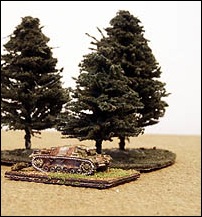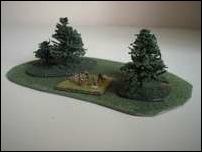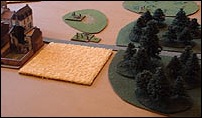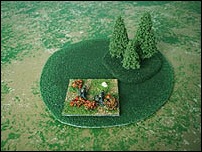Trees
 A German StuG III (GHQ) in front of some homemade fir trees. |  GHQ British infantry in a home-made wood. The infantry base is 30 mm square. |
Making trees yourself
I use the bottle-brush method. This is good for conifers, not so good for deciduous, and useless for palm trees. See the foliage page for info on deciduous trees.
To do it my way you will need:
• Thin soft iron wire (0.5 mm or so diameter, available from gardening shops)
• Sisal (course string, available from gardening shops)(and it has to be sisal other things don't work as well)
• Green flock powder (I like Gaugemaster dark green for my 6 mm scale trees, other stuff seems too course)
• PVA adhesive Cheap green acrylic paint
• A plastic tub big enough to fit one of your trees in
• Some polystrene block
• A hand drill or electric screwdriver
• Matt spray varnish
 GHQ German infantry advance from a wood (home-made) towards the village (home-made), carefully avoiding the field that would have given some cover! |  German HMG section (GHQ) in a wood with TimeCast trees. |
Step 1 - Cut the sisal into about 3 inch lengths and soak in warm water, preferably overnight. This makes the sisal unravel into individual strands.
Step 2 - Dry out the sisal.
Step 3 - Cut a length of wire about two foot long. Bend in half back on itself and twist ends together to form a loop.
Step 4 - Hook the loop over something that's not going to move (door handle or whatever). Fix the other end to your drill/screwdriver. Pull gently towards you to make the sides of the loop close together.
Step 5 - Slip bundles of sisal into the loop about every 6 inches or so, spreading the strands out so that they form the height of the tree along the loop.
Step 6 - Start winding and stop when the wire breaks (which always happens at one end of the loop). You will now have a load of things that look like bottle cleaning brushes.
Step 7 - Cut the wire at the treetops. Keep the trunks longer than you need. Then use scissors to trim the trees to the required shape. This is normally conical for coniferous. Deciduous are hemispherical, spherical, or irregular. Have a look at a gardening book!
Step 8 - Dilute some PVA adhesive with water and stir in some green paint. Dunk a tree into this, then spin it in your tub to remove excess. (Tub is v. important, otherwise paint goes everywhere and you become very unpopular)
Step 9 - Drizzle on copious amounts of flock powder.
Step 10 - Stick trunk into polystyrene block and leave to dry
Step 11 - Tap tree to remove excess flock. Either trim your trunk to the correct length and glue into a hole in your tree base (I use 2 mm MDF) or cut too long and unravel the wires and splay to form roots, and then glue this down (a hot glue gun works well). I now prefer the first method.
Step 12 - After flocking the base, varnish well to keep the flock on. This all takes a bit of practice, but isn't too difficult and the trees look good. I made about 25 the other weekend this way. I mounted them in groups of two or three.
Commercial trees
TimeCast do trees for about 37 p each, so I may not be making trees myself much longer!
TimeCast's web address is on the links page. Their buildings are very good too!
A note about flock colours
I use a few movable tree bases on larger flocked upside down adhesive plastic floor tiles that denote the area of the wood. I initially thought about using a browny forest floor colour for the tree base and the wood, but in the end decided to use the same colour as the trees. This helps the wood to look like a wood, rather than a few lonely trees in a clearing.

